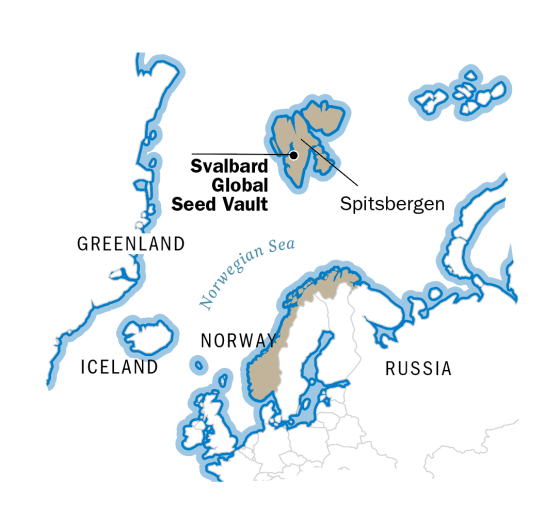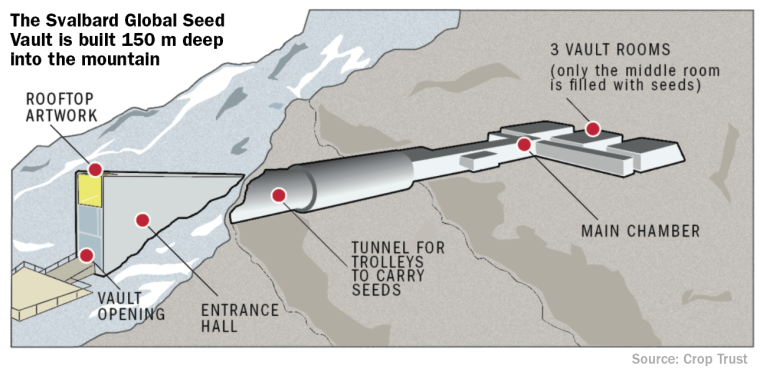Putin You Have Agraculture and a Lot of Minerials I Know You Protect the Ice Land
Information technology is essentially a huge safety eolith box, belongings the world's largest collection of agricultural biodiversity.
inside The 'Doomsday' Vault
By jennifer duggan / spitsbergen
Deep in the bowels of an icy mountain on an island above the Arctic Circle between Norway and the North Pole lies a resource of vital importance for the time to come of mankind. Information technology's not coal, oil or precious minerals, simply seeds.
Millions of these tiny brown specks, from more than 930,000 varieties of food crops, are stored in the Global Seed Vault on Spitsbergen, part of Kingdom of norway's Svalbard archipelago. Information technology is essentially a huge safety deposit box, holding the earth's largest drove of agricultural biodiversity. "Inside this building is xiii,000 years of agricultural history," says Brian Lainoff, lead partnerships coordinator of the Crop Trust, which manages the vault, every bit he hauls open the huge steel door leading inside the mount.

It would exist difficult to find a place more remote than the icy wilderness of Svalbard. It is the farthest due north you tin can fly on a commercial airline, and autonomously from the nearby town of Longyearbyen, it is a vast white area of frozen emptiness.
The Global Seed Vault has been dubbed the "doomsday" vault, which conjures upward an epitome of a reserve of seeds for use in case of an apocalyptic event or a global catastrophe. Merely it is the much smaller, localized destruction and threats facing factor banks all over the world that the vault was designed to protect against—and it's why the vault was opened in February, when TIME visited.
On this occasion, samples from Republic of india, Pakistan and Mexico were being deposited aslope seeds from Syria, many of whose citizens are living through their own apocalypse. "There are big and small doomsdays going on around the world every twenty-four hour period. Genetic material is being lost all over the earth," says Marie Haga, executive managing director of the Ingather Trust. This past wintertime offered the factor bank a chance to redress the balance.
Nigh the entrance to the facility, a rectangular wedge of concrete that juts out starkly confronting the snowy landscape, the doomsday nickname seems eerily apt. It was precisely for its remoteness that Svalbard was chosen as the location of the vault. "It is away from the places on earth where you take war and terror, everything maybe you are afraid of in other places. It is situated in a condom identify," says Bente Naeverdal, a property manager who oversees the day-to-twenty-four hour period operation of the vault.
Its only neighbour is a like repository buried abroad from the dangers of the world: the Chill World Archive, which aims to preserve data for the world'due south governments and private institutions, opened deep in a nearby mine on March 27.

The entrance leads to a small tunnel-similar room filled with the loud whirring noise of electricity and cooling systems required to go on the temperature within the vault consistent. Through one door is a wide concrete tunnel illuminated past strip lighting leading 430 ft. down into the mount. At the terminate of this corridor is a chamber, an added layer of security to protect the vaults containing the seeds.
There are iii vaults leading off from the chamber, merely merely one is currently in utilise, and its door is covered in a thick layer of ice, hinting at the subzero temperatures within. In here, the seeds are stored in vacuum-packed silver packets and test tubes in large boxes that are neatly stacked on flooring-to-ceiling shelves. They have very little monetary value, but the boxes potentially agree the keys to the future of global food security.
Over the past 50 years, agronomical practices have changed dramatically, with technological advances allowing large-scale crop production. But while crop yields have increased, biodiversity has decreased to the betoken that now only most 30 crops provide 95% of human nutrient-free energy needs. Only ten% of the rice varieties that China used in the 1950s are notwithstanding used today, for example. The U.S. has lost over 90% of its fruit and vegetable varieties since the 1900s. This monoculture nature of agriculture leaves food supplies more susceptible to threats such equally diseases and drought.
The seeds lying in the deep freeze of the vault include wild and one-time varieties, many of which are not in general use anymore. And many don't exist outside of the seed collections they came from. Simply the genetic diverseness independent in the vault could provide the Dna traits needed to develop new strains for any challenges the world or a particular region will face in the future.One of the 200,000 varieties of rice within the vault could have the trait needed to adjust rice to higher temperatures, for example, or to observe resistance to a new pest or disease. This is particularly important with the challenges of climate change. "Not too many think about crop diverseness as beingness so fundamentally important, but it is. It is well-nigh as important every bit h2o and air," says Haga. "Seeds generally are the basis for everything. Not but what we eat, but what we wear, nature all nigh united states."
At that place are as many as 1,700 versions of the vault, called gene banks, all over the globe. This global network collects, preserves and shares seeds to further agricultural research and develop new varieties. The Svalbard vault was opened in 2008, effectively as a fill-in storage unit for all those hundreds of thousands of varieties. The thought was conceived in the 1980s by Cary Fowler, a former executive director of the Crop Trust, but only started to become reality after an International Seed Treaty negotiated by the U.Due north. was signed in 2001. Structure was funded by the Norwegian government, which operates the vault in partnership with the Crop Trust. The goal is to find and house a copy of every unique seed that exists in the global factor banks; shortly the vault will make room for its millionth diversity. Information technology too works in tandem with those gene banks when their textile is lost or destroyed.
At the end of one of the long rows of seeds within the vault, a big and symbolic gap has just merely been refilled. The black boxes there wait like all the others in the vault, just they have had a long journeying. The International Center for Agronomical Research in the Dry out Areas (ICARDA) is a global agricultural-research organization that had been based in Syrian arab republic but was forced to flee its headquarters, just outside of Aleppo, because of the civil war. The system evacuated its international staff in 2012, but some Syrian researchers stayed behind to rescue equipment and fifty-fifty animals.
Merely every bit the fighting intensified, they were forced to leave backside their gene bank, i of the earth'due south nearly valuable collections of seeds, containing some of the oldest varieties of wheat and barley. ICARDA re-established its headquarters in Morocco and Lebanon, and restarted the gene bank in 2015 using seeds from the Svalbard vault—the start-ever withdrawal there. Woken from their icy slumber, the seeds were planted in Lebanon's Bekaa Valley and in Morocco, and their offspring were advisedly nerveless and processed to render to the vault. In late February, ICARDA returned the varieties of seeds information technology had taken out. "These seeds accept come total circle," Lainoff explains.
The gene bank in Aleppo was non the first to be threatened by state of war. Factor banks in Afghanistan and Iraq have been destroyed, along with them genetic material that wasn't backed up in Svalbard. But information technology is not merely armed conflict that threatens these valuable resources. Some have been hit by natural disasters, similar the Philippine national gene depository financial institution, which was damaged by flooding from a draft and later a fire. Simply a lack of resources is probably the biggest threat facing the world's cistron banks.
Woefully underfunded, many lack the resources to properly store or protect the seeds they hold. The Ingather Trust is at present raising coin for an endowment fund to ensure that the world'due south 1,700 factor-bank facilities are able to continue interim as guarantors of global biodiversity.
You don't need to look far to discover the sacrifices fabricated to proceed these kernels of reproduction safe. One of the most historically meaning deposits of seeds inside the vault comes from a collection in Petrograd's Vavilov Research Institute, which originates from 1 of the start collections in the earth. During the siege of Leningrad, about a dozen scientists barricaded themselves in the room containing the seeds in society to protect them from hungry citizens and the surrounding German ground forces.
Every bit the siege dragged on, a number of them eventually died from starvation. Despite being surrounded by seeds and plant material, they steadfastly refused to save themselves past eating any of it, such was their confidence nearly the importance of the seeds to help Russian federation's recovery after state of war and to help protect the future of humankind. One of the scientists, Dmitri Ivanov, is said to have died surrounded past bags of rice.
In an age of heightened geopolitical tensions and uncertainty, the Svalbard vault is an unusual and hopeful exercise in international cooperation for the practiced of humankind. Whatever arrangement or land tin send seeds to information technology, and there are no restrictions because of politics or the requirements of diplomacy. Carmine wooden boxes from Democratic people's republic of korea sit aslope black boxes from the U.S. Over on the next aisle, boxes of seeds from Ukraine sit atop seeds from Russia. "The seeds don't care that there are North Korean seeds and S Korean seeds in the same alley," Lainoff says. "They are cold and safe up there, and that'due south all that really matters."
Reporting for this article was supported by a grant from the Pulitzer Center on Crisis Reporting
Source: https://time.com/doomsday-vault/
0 Response to "Putin You Have Agraculture and a Lot of Minerials I Know You Protect the Ice Land"
Yorum Gönder